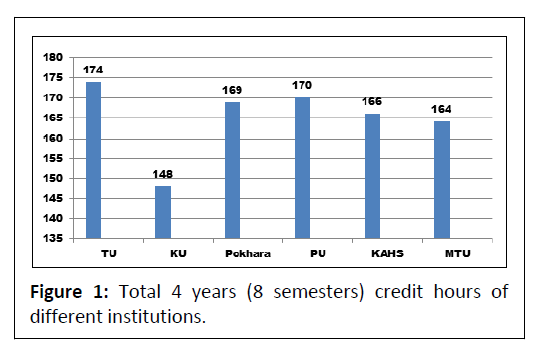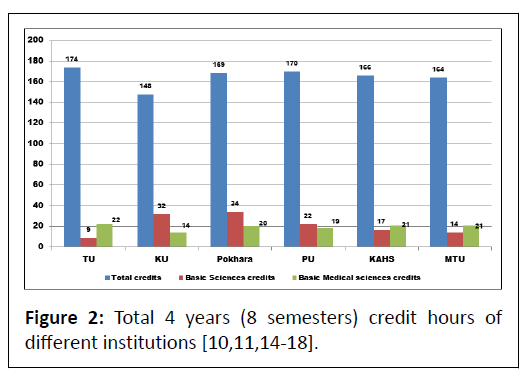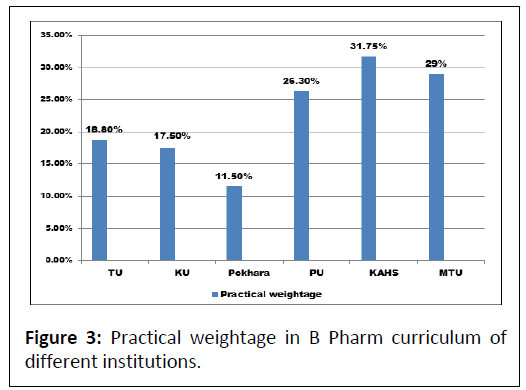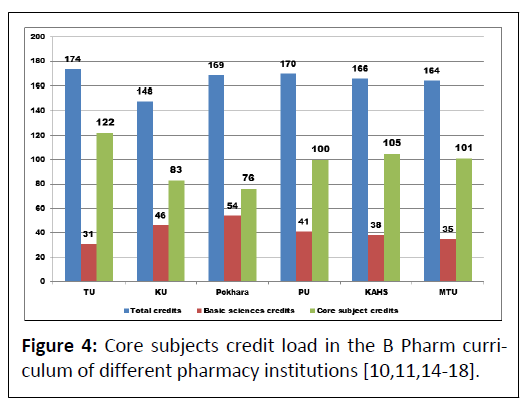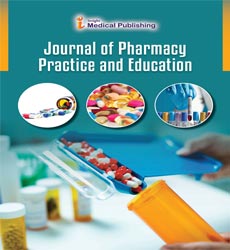A Comparison of Bachelor of Pharmacy (B Pharm) Curricula of Nepalese Universities and Health Sciences Academies: An Exploratory Study
Dharma Prasad Khanal1*, Saibijaya Rijal2, Anil Kumar Shah3 and Bijaya Aryal4
1Department of Pharmacy, Manmohan Memorial Institute of Health Sciences, Tribhuvan University, Kathmandu, Nepal
2Department of Pharmacy, Manmohan Technical University, Budhiganga-4, Nepal
3Department of Pharmacy, Purbanchal University, Morang, Nepal
4Department Pharmacy, Karnali Academy of Health Sciences, Jumla, Nepal
- *Corresponding Author:
- Dharma Prasad Khanal
Department of Pharmacy,
Manmohan Memorial Institute of Health Sciences,
Tribhuvan University, Kathmandu,
Nepal,
E-mail: drdharmakhanal@gmail.com
Received date: April 17, 2023, Manuscript No. IPPPE-23-16410; Editor assigned date: April 19, 2023, PreQC No. IPPPE-23-16410 (PQ); Reviewed date: May 01, 2023, QC No. IPPPE-23-16410; Revised date: May 11, 2023, Manuscript No. IPPPE-23-16410 (R); Published date: May 18, 2023, DOI: 10.36648/ipppe/6.1.069.
Citation: Khanal DP, Rijal S, Shah AK, Aryal B (2023) A Comparison of Bachelor of Pharmacy (B Pharm) Curricula of Nepalese Universities and Health Sciences Academies: An Exploratory Study. J Pharma Prac Edu Vol.6 No.1: 069.
Abstract
Background: Four federal government universities, two state government universities and two health science academies are conducting bachelor of pharmacy (B Pharm) program in 27 pharmacy colleges with the enrollment of 815 students in academic year 2023/24. Tribhuvan University is adopting year system where as all other seven universities and academies are adopting eight semester’s system. The curricula of all pharmacy institution vary with the priority in different areas of pharmacy practice.
Objective: To compare the content of existing and available text-based documents describing curricular contents provided by all Bachelor of Pharmacy (B Pharm) course conducting institutions of Nepal.
Method: The present curriculums of the universities were requested from the four Departments of Pharmacy of the respective university and health science academies where authors are not affiliated. Individual pharmacy council’s regulations were downloaded adopting narrow topic search for the respective country’s pharmacy council name. Curriculum’s subject labels together with academic credits or contact hours were retrieved from the collected documents. This exploratory study employed analysis of curriculums content of existing and available text-based documents describing curricular contents provided by all institutions. Subjects are divided into three categories: Basic sciences (basic chemistry, mathematics, algebra, calculus, computer and python program), basic medical sciences (anatomy, physiology, pathology, pathophysiology, biochemistry and microbiology) core subjects (pharmacognosy, pharmacology, pharmacotherapeutics, pharmaceutical engineering, pharmaceutics, medicinal/ pharmaceutical chemistry, pharmaceutical analysis, herbal drugs, hospital pharmacy, clinical pharmacy, community pharmacy).
Results: Total 4 years or 8 semester’s credits of B Pharmacy course vary from 148 credits of Kathmandu University to 174 credits of Trribhuvan University. Maximum practical load is 31.75% with Karnali Academy of Health Sciences and lowest 11.00% with Pokhara University. The practical load is below 20% in the curriculum of Pokhara University, Tribhuvan University and Kathmandu University (KU). Total 21.60% (32 credits out of 148 credits) is allocated in KU only for basic sciences where as Pokhara University spending 20.50% (34 credits out of 166 credits). In KU first year is common with engineering students and in Pokhara University “Chemical Name Reaction” is taught in 5th semester. In Trribhuvan University curriculum basic sciences are totally neglected and only 5% (9 credits out of 174 credits). Other pharmacy college like PU 12.90% (22 credits out of 170 credits), KAHS 10.24% (17 credits out of 166) and MTU 8.54% (14 credits out of 164) respectively.
Conclusion: We found large variation in Pharmacy Curricula of Nepalese Education Institutions. Competency based curriculum are necessary for the fulfillment of the demand of qualified pharmacy manpower for the safeguard of the public health. Harmonization of the curricula is desirable for uniform pharmacy education in the country.
Keywords
Curriculum; Pharmacy education; Credits; Theory; Practical
Introduction
After the Suguali Treaty and the establishment of British residence in Nepal in 1816 AD, allopathic medicine (modern medicine) was introduced in the country [1,2]. Tribhuvan University Institute of Medicine began offering the proficiency certificate in pharmacy, a two and a half year intermediate course in pharmacy in 1972. In 1994, a pharmacy undergraduate program was launched at Kathmandu University in Dhulikhel for the first time in Nepal. With the establishment of more than 25 Diploma of Pharmacy Colleges across the nation under the affiliation of Council for Technical Education and Vocational Training (CTEVT), Ministry of Education, Government of Nepal, Sanothimi, Bhaktpur, mass production of pharmacy assistant started. Nepal pharmacy council act was promulgated by the government of Nepal in the year 2000 and pharmacy council start the license examination for both pharmacy assistants and graduate pharmacists having B Pharm and Pharm D first degree in 2013 [3]. Presently there are 27 pharmacy colleges under eight different universities and health science academies in Nepal. The total annual enrollment in the academic year 2023/24 is 815 students [4].
Pharmacy education is skill based teaching learning and asks the adequate emphasis is necessary for Problem Based Learning (PBL), laboratory practical skills as well as clinical posting. If the number of hours in a day hasn't changed to suit the expansion of knowledge in health care related competencies, it is difficult to adjust in practice area. I contrast to global practice; pharmacists are not included in the health care team of Nepalese health care system and mostly engaged in the other area of pharmacy practice [5]. “Globally, pharmacy practice and education are undergoing unprecedented change as the role of the pharmacist as a provider of healthcare services is increasingly recognized, valued and expanded” [6]. Pharmaceutical practice, pharmacy education and education quality assurance systems vary from nation to nation. Although changes in practice and education are lessening this variation, differences today are nevertheless viewed as being very considerable on a worldwide scale. Pharmacy education in Europe (PHARMINE) project compared IPET curricula between 26 European countries aiming to ensure harmonization of education throughout European countries in line with the mutual recognition of pharmacy programs [7-9]. The transition of pharmacy schools to a six-year educational program in 2006 in many part of the world is a turning point of pharmacy education that is still to adopt in Nepal.
There is a substantial variation in the curricula of different universities and health science academies in Nepal. Some are practicing year’s system; most of them are practicing semester system. The total 4 years or 8 semester’s credits vary from 148 credits of Kathmandu University to 174 credits of Trribhuvan University [10,11]. The main objective of this article is to critically analyze the weakness and strength their curriculums. The goal of pharmaceutical education is to give students a curriculum that, through its structure and method of delivery, teaches them the knowledge, abilities and moral principles required to address society's drug-related information.
Materials and Methods
Research design
Descriptive exploratory.
Research settings
Bachelor of Pharmacy (B Pharm) course conducting universities and health science academies of Nepal.
Study unit
Curricula of B Pharm of different universities and health science academies of Nepal.
Sampling method
Purposive.
Sample size
27 (Twenty Seven).
The present curriculums of the universities were requested from the four departments of pharmacy of the respective university and health science academies where authors are not affiliated. Individual pharmacy council’s regulations were downloaded adopting narrow topic search for the respective country’s pharmacy council name. Curriculum’s subject labels together with academic credits or contact hours were retrieved from the collected documents. This exploratory study employed analysis of curriculums content of existing and available textbased documents describing curricular contents provided by all institutions.
Criteria for sample selection
Pharmacy Institution that has B Pharm course running.
Instrumentation
A data collection form was developed containing total duration of the course, year/semester wise credit distribution, credit load for basic science, basic medical sciences, practical and core pharmaceutical sciences.
Ethical approval and data collection
The ethical approval was granted from the Institutional Research Committee (IRC) of Manmohan Memorial Institute of Health Sciences.
Data analysis procedure
Curriculum subjects are divided into three categories: Basic sciences: (Basic chemistry, mathematics, algebra, calculus, computer and python program), basic medical sciences: (Anatomy, physiology, pathology, pathophysiology, biochemistry and microbiology) core pharmaceutical science: (Pharmacognosy, pharmacology, pharmacotherapeutics, pharmaceutical engineering, pharmaceutics, medicinal/ pharmaceutical chemistry, pharmaceutical analysis, herbal drugs, hospital pharmacy, clinical pharmacy, community pharmacy).
The data were checked for completeness, coded and entered into XL-sheet. The obtained data was analyzed based on objectives of the study using descriptive statistics and is presented in different Tables and Graphs.
Results and Discussion
We could not found any literature regarding the comparison of undergraduate curricula of Nepalese university conducting undergraduate pharmacy program. According to the regulations of pharmacy council of India [12] all bachelor of pharmacy programs in India shall be of 8 semester duration. In Pakistan, five years doctor of pharmacy program is implemented since 2005 [13].
The maximum credits hours 174 of Tribhuvan University and minimum 148 with Kathmandu University [10,11]. All other institutions have around 160 credits in 8 semesters [10,11,14-18] (Figure 1). Similar provision for four years course is adopted in Bangladesh [19]. Three federal universities are distributing affiliations to twenty colleges, TU had seven affiliated colleges and one constitute college, Pokhara had four affiliated colleges and one constitute college and Purbanchal University had eight affiliated colleges and one constitute college (Tables 1 and 2).
| Institution | TU | KU | Pokhara university | PU | KAHS | MBAHS | GU | MTU | MEC allocated seats for 2023/24= 765 seats out of which 190 for scholarship |
|---|---|---|---|---|---|---|---|---|---|
| Location provence | Bagmati | Bagmati | Gandaki | Koshi | Karnali | Bagmati | Gandaki | Koshi | |
| Affiliation distribution | Bagmati -5 Gandaki -1 Lumbani -1 | No | Bagmati-3 Lumbani -1 | Bagmati-7 Gandaki -1 | No | No | No | No | |
| Total | 8 colleges | One | 5 colleges | 9 colleges | One | One | One | One | 27 colleges |
| Total seats 2023/24 | 260 | 50 | 180 | 245 | 20 | 30 | 20 | 10 | 815 |
| Source: Medical education commission, letter ref no: 079/80, dated 14th march 2023 and undergraduate entrance result MECEE-BL 2023, dated 18th march 2023. Note: TU: Tribhuvan University; KU: Kathmandu University; PU: Purbanchal University; GU: Gandaki University; MTU: Manmohan Technical University; KAHS: Karnali Academy of Health Sciences; MAHS: Madan Bhandary Academy of Health Sciences. |
|||||||||
Table 1: Total educational institutions offering bachelor of pharmacy course in academic year 2023/24 [10,11,14-18].
| Institution | TU | KU | Pokhara | PU | KAHS | MBAHS | GU | MTU |
|---|---|---|---|---|---|---|---|---|
| Duration | 4 years | 8 semesters | 8 semesters | 8 semesters | 8 semesters | 8 semesters | 8 semesters | 8 semesters |
| Total credits | 174 | 148 | 166 | 170 | 166 | Not mention any credits in curriculum 8 weeks | 168 | 164 |
| 1st year | 42 | 18+20 | 19+22 | 21+21 | 22+22 | 21+21 | 22+22 | |
| 2nd year | 48 | 18 +19 | 22+22 | 21+22 | 22+21 | 23+23 | 22+24 | |
| 3rd year | 48 | 19+19 | 22+22 | 23+21 | 22+21 | 23+23 | 22+22 | |
| 4th year | 36 | 19+16 | 22+15 | 21+20 | 21+15 | 19+15 | 20+10 | |
| Professional internship | 4 weeks each | 4-6 weeks industry only | 4 weeks each | 6 weeks | 6 weeks | Not clear | 4 weeks | |
| Note: TU: Tribhuvan University; KU: Kathmandu University; Pokhara: Pokhara University; PU: Purbanchal University; GU: Gandaki University; MTU: Manmohan Technical University; KAHS: Karnali Academy of Health Sciences; MAHS: Madan Bhandary Academy of Health Sciences. | ||||||||
Table 2: B Pharm course duration, total and year wise credits distribution [10,11,14-18].
Laboratory practical and practice site posting is an essential component of pharmacy education in order to allow intern students to experience real conditions and training opportunities in different practice settings. Pharmacy colleges are now required to integrate experiences into their curricula to develop the expected practice competencies. Practical part in pharmacy education is a key element in the curricula of different pharmacy colleges, yet the twenty seven colleges provide practical learning at different qualities and quantities (Figure 2). We have to realize in Nepal that there are limited field posting sites for all colleges (Tables 3 and 4).
| Institution | TU | KU | Pokhara | PU | KAHS | MBAHS | GU | MTU |
|---|---|---|---|---|---|---|---|---|
| Duration | 4 years | 8 semesters | 8 semesters | 8 semesters | 8 semesters | 8 semesters | 8 semesters | 8 semesters |
| Total credits | 174 | 148 | 166 | 170 | 166 | Not mention any credits in curriculum. | 168 | 164 |
| Theory | 138 | 120 | 139 | 122 | 126 | 134 | 119 | |
| Practical | 26 (18.8%) | 21 (17.50%) | 19 (11.00%) | 32 (26.23%) | 40 (31.75%) | 34 (20%) | 35 (29%) | |
| Project work | 6 | 6 | 6 | 6 | 6 | 6 | 6 | |
| Internship | 4 | 1 | Non credit | 6 | 8 | One credits | 4 | |
| Note: TU: Tribhuvan University; KU: Kathmandu University; PU: Purvanchal University; GU: Gandaki University; MTU: Manmohan Technical University; KAHS: Karnali Academy of Health Sciences; MAHS: Madan Bhandary Academy of Health Sciences. | ||||||||
Table 3: Theory and practical ratio [10-16].
| Year | TU | KU | Pokhara | PU | KAHS | MTU | ||||||
|---|---|---|---|---|---|---|---|---|---|---|---|---|
| T | P | T | P | T | P | T | P | T | P | T | P | |
| 1st | 42 | 6 | 34 | 4 | 38 | 6 | 31 | 9 | 34 | 10 | 33 | 11 |
| 2nd | 36 | 12 | 29 | 8 | 38 | 6 | 30 | 10 | 34 | 9 | 36 | 10 |
| 3rd | 36 | 6 | 29 | 9 | 38 | 6 | 33 | 9 | 33 | 10 | 34 | 8 |
| 4th | 15 | 2 | 30 | 5 | 24 | 4 | 28 | 6 | 21 | 9 | 16 | 3 |
| Seminar | ||||||||||||
| Project | 6 | 6 | 6 | 6 | 6 | 6 | ||||||
| Internship | 4 | 1 | Non credit | 6 | 8 | 4 | ||||||
| Total | 139 | 26 | 129 | 26 | 142 | 22 | 134 | 34 | 136 | 38 | 129 | 32 |
| Note: T: Theory; P: Practical; %: Percentage; TU: Tribhuvan University; KU: Kathmandu University; PU: Purvanchal University; GU: Gandaki University; MTU: Manmohan Technical University; KAHS: Karnali Academy of Health Sciences. | ||||||||||||
Table 4: Theory and practical credits distribution in B Pharm course in different institutions [10,11,14-18].
First year curriculum
In first year minimum 36 credits is taught in TU and maximum 44 credits taught in KAHS and MTU. As a principal and common academic practice first year curriculums shall contain basic sciences. But TU curriculum braked the trend and all chemistry subjects (viz: Inorganic chemistry, organic chemistry, biochemistry, medicinal chemistry) and pharmacology are scheduled in first year when students had not listen the lectures of basic sciences organic chemistry, physiology etc. It is theoretically injustice and practically unmanageable to carry the normal teaching learning session. Moreover 25% anatomy, 50% physiology and 25% pathology is collect in one subject. In the 1st year (1st and 2nd semester) of the program, students will be taught basic education courses such as chemistry, anatomy, math etc. this is also difficult for the students. In Kathmandu University first year is common course with engineering students and subjects like general physics, information system technology, computer programming with Python etc. are taught. It is very good but not knowing the core courses of pharmaceutical sciences, information technology might be worthless (Table 5).
| Institution | Subject | Theory credits | Practical credits | Load% |
|---|---|---|---|---|
| TU | Organic + inorganic chemistry (6 credits) | 6 | 3 | 5 |
| Anatomy + physiology + pathology (one subject-theory only), biochemistry and microbiology | 18 | 4 | 12.65 | |
| KU | Calculus and algebra, general physics, general chemistry, information systems technology, foundation course in pharmacy, professional communication, general cell biology, reaction mechanism and stereo chemistry, computer programming with python, organic chemistry, inorganic pharmaceutical chemistry | 28 | 4 | 21.6 |
| Pharmaceutical microbiology and Immunology, biochemistry, physiology and pathophysiology | 11 | 3 | 9.45 | |
| Pokhara | General chemistry, stereochemistry & reaction mechanism, algebra, trigonometry, calculus, computer science, communication skill, medicinal botany, chemistry of natural products and biostatistics | 27 | 7 | 20.5 |
| Biochemistry, anatomy and physiology, microbiology and immunology | 15 | 5 | 11.8 | |
| PU | Pharmaceutical chemistry (inorganic & organic), physical chemistry, and basic computer application. | 18 | 4 | 12.9 |
| Anatomy & physiology, microbiology, biochemistry and pathophysiology | 15 | 4 | 11.2 | |
| KAHS | Inorganic pharmaceutical chemistry, organic pharmaceutical chemistry, mathematics, computer application, phytochemistry | 13 | 4 | 10.2 |
| Human anatomy, pharmaceutical biochemistry, microbiology & immunology physiology and human pathology | 16 | 5 | 12.65 | |
| MTU | Pharmaceutical chemistry-I (inorganic), mathematics for pharmacy, pharmaceutical chemistry-II (organic) | 11 | 3 | 8.54 |
| Anatomy and physiology-I/ II, pathophysiology-I/II, pharmaceutical microbiology and immunology, pharmaceutical biochemistry and pharmaceutical biotechnology and pharmacogenetics | 15 | 6 | 12.8 | |
| Note: T: Theory; P: Practical; %: Percentage; TU: Tribhuvan University; KU: Kathmandu University; PU: Purvanchal University; GU: Gandaki University; MTU: Manmohan Technical University; KAHS: Karnali Academy of Health Sciences. | ||||
Table 5: Basic science and basic medical science subjects [10,11,14-18].
Maximum practical load is 31.75% with KAHS and lowest 11.00% with Pokhara University. The practical load is below 20%in the curriculum of Pokhara, TU and KU (Figure 3).
Pokhara University only taught Biostatics in 2nd semester and it is too early for pharmacy students. Basic science credit load range from 5% in TU to maximum KU 21.60 viz: Kathmandu University spending 21.60% (32 credits out of 148 credits) only for basic sciences where as Pokhara University spending 20.50% (34 credits out of 166 credits).
In Kathmandu University first year is common with engineering students and in Pokhara University “Chemical Name Reaction” is taught in 5th semester. In Tribhuvan University curriculum basic sciences are totally neglected and only 5% (9 credits out of 174 credits). Other pharmacy college like PU 12.90% (22 credits out of 170 credits), KAHS 10.24% (17 credits out 166) and MTU 8.54% (14 credits out of 164) respectively.
Talking about the basic medical science subjects like anatomy, physiology, pathology, biochemistry and microbiology, the maximum credits load is with is with TU having 22 credits out of 174 credits (12.65%) but 6+2 credits each allocated for biochemistry and microbiology and rest 6 credits are allocated to the mixed theory subject containing 25% anatomy, 50% physiology and 25% pathology. This subject is very difficult for students (Figure 4).
Conclusion
We found large variation in pharmacy curricula of Nepalese Education Institutions running 4 years/8 semesters Bachelor of Pharmacy Program. Total credits in four years/eight semesters range from 148 credits (KU) to 174 credits (TU). One academic year maximum load 48 credits (TU) in first year to lowest load 29 credits (KU) in second year. Substantial variation in the practical portion of the curriculums ranging from 11.5% of Pokhara to 31.75% of KAHS. Harmonization of the curricula is desirable for uniform pharmacy education in the country.
Competency based curriculum are necessary for the fulfillment of the demand of qualified pharmacy manpower for the safeguard of the public health. This is the turning point of pharmacy education as by law of Nepal, the medicinal education commission is responsible for the accreditation of the pharmacy education. So this paper may be useful for the study of history of pharmacy education in Nepal.
Contributions by Authors
• 1st author: Design the article format and acquire curriculums from TU, Pokhara University and KU. Analyzed the annex information. Edit graphs and prepare the final article.
• 2nd author: Collect the curriculum from MTU and initiate analysis and edit the overall credits and practical weightage of the institutions.
• 3rd author: Collect the curriculum from PU and initiate analysis and edit the first year and 2year details of the institutions.
• 4th author: Provide the curriculums of KASH. Prepare the draft table of the annex information. Edit graphs.
Conflict of Interest
There is any conflict of interest of the authors to declare.
References
- Marasini BR (2003) Hospital development in Nepal: Past and present. J Nepal Med Assoc 42: 306-311.
- Thapa B, Prasad R, Shrestha N, Bhuju G, Shrestha BM (1997) Nepalese pharmaceutical guide. (2nd ed), Associated Pharma-tech Consultancy Pvt Ltd, Kathmandu, Nepal.
- Khanal DP (2018) History of pharmaceutical development in Nepal. JMMIHS 3: 86-93.
[Crossref], [Google Scholar]
- https://entrance.mec.gov.np/Download?fileName=UG2023BDS_Final_Result.pdf
- http://www.nhssp.org.np/NHSSP_Archives/human_resources/HRH_draft_plan_january2012.pdf
- Uejima E (2020) Global standards for pharmaceutical education. Yakugaku zasshi 140: 677-685.
[Crossref], [Google Scholar], [Indexed]
- The International Forum for Quality Assurance of Pharmacy Education (2008) A global framework for quality assurance of pharmacy education.
- Arakawa N, Bruno A, Bates I (2020) A global comparison of initial pharmacy education curricula: An exploratory study. Innov Pharm 11: 1-13.
[Crossref], [Google Scholar], [Indexed]
- Kushwaha K, Kushwaha N, Rai AK (2010) Recent trends on the future of graduate education in the pharmaceutical sciences and research. J Young Pharm 2: 206-212.
[Crossref], [Google Scholar], [Indexed]
- School of Science (2003) Course Structure for all programs in Pharmacy Department. Department of Pharmacy.
- Institute of Medicine (2019) Curriculum structure of bachelor of pharmacy. Pharma Info Nepal.
- Pharmacy council of India New Delhi rules & syllabus for the Bachelor of Pharmacy (B. Pharm) Course. [Framed under Regulation 6, 7 & 8 of the Bachelor of Pharmacy (B. Pharm) course regulations 2014.
- Pharmacy council of Pakistan (2005) Doctor of pharmacy degree course regulations.
- KAHS Syllabus (2021) Karnali Academy of Health Sciences. Bachelor of Pharmacy.
- Purbanchal University, Faculty of Medical and Allied Sciences (2007). Curriculum of Bachelor of Pharmacy (B Pharm). Department of Pharmacy.
- The School of Pharmaceutical and Biomedical Sciences Faculty of Science and Technology (2007) Bachelor of Pharmaceutical Sciences. Department of Pharmacy.
- Madan Bhandari Academy of Health Sciences (2021) Curriculum of Bachelor of Pharmacy.
- Manmohan Technical University (2019) Curriculum of Bachelor in Pharmacy (4 years program – semester system), Nepal.
- Pharmacy Council of Bangladesh. Guidelines for Accreditation/ Recognition of Bachelor of Pharmacy (B. Pharm.). Education in Public and Private Universities.
Open Access Journals
- Aquaculture & Veterinary Science
- Chemistry & Chemical Sciences
- Clinical Sciences
- Engineering
- General Science
- Genetics & Molecular Biology
- Health Care & Nursing
- Immunology & Microbiology
- Materials Science
- Mathematics & Physics
- Medical Sciences
- Neurology & Psychiatry
- Oncology & Cancer Science
- Pharmaceutical Sciences
